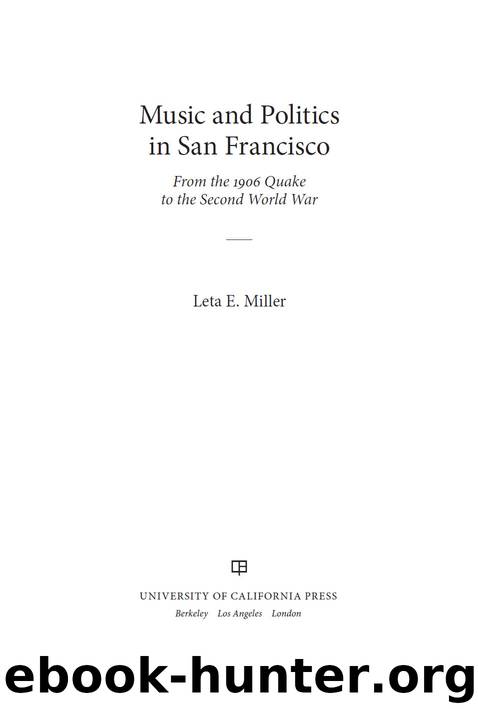Music and Politics in San Francisco by Miller Leta E

Author:Miller, Leta E.
Language: eng
Format: epub
Publisher: University of California Press
Published: 2012-04-10T04:00:00+00:00
HENRY COWELL’S EXPLORATION OF SLIDING TONES AND WORLD MUSICS
Cowell’s eclectic education and exposure to ethnic diversity, coupled with his “independence of judgment” and “opinions on all kinds of matters,” led to his interest in, and advocacy of, a wide variety of world musics. Sliding tones (a notable feature of Chinese music) begin to appear in his works around 1925, and his influential New Musical Resources includes an interesting aside on them.28 “Natural sounds,” he wrote,
such as the wind playing through trees or grasses, or whistling in the chimney, or the sound of the sea, or thunder, all make use of sliding tones. It is not impossible that such tones may be made the foundation of an art of composition by some composer who would reverse the programmatic concept. . . . Instead of trying to imitate the sounds of nature by using musical scales, which are based on steady pitches hardly to be found in nature, such a composer would build perhaps abstract music out of sounds of the same category as natural sound—that is, sliding pitches—not with the idea of trying to imitate nature, but as a new tonal foundation.29
Cowell did not specifically link such sliding tones to the Chinese theater, but he did remark that “ever-changing values of pitch” are characteristic of “Oriental music.” New Musical Resources was first published in 1930, but its origin dates back more than ten years earlier. Significantly, the sliding tone passage quoted here does not appear in the book’s original manuscript; Cowell seems to have added it in a revision during the 1920s.30 This fact, along with his first use of sliding tones as a compositional tool in the same period, suggests that the Chinese opera, readily available to non-Chinese audiences in San Francisco with the opening of the Mandarin Theatre in 1924, might have served as a stimulus.
Despite this likely influence, Cowell rarely used sliding tones to evoke images of Asia.31 Among his earliest compositions to specify slides is the nonprogrammatic Composition for String Piano and Ensemble (1925). Here the pianist produces a “slow slide” from D-flat to C using a flat metal object (preferably a chisel). Later in the work the pianist performs wider slides over multiple octaves by gliding over the strings with the fingers or sweeping back and forth on them with the fingernail.
In the same period (probably 1926) Cowell called for extensive slides in both voices and string instruments in Atlantis, a never-completed theatrical dance work for three vocalists and chamber orchestra. He composed this nine-movement, sixteen-minute suite on a $400 commission from painter-writer Alice Pike Barney, who created its scenario. Barney projected Cowell’s suite as the prologue of a two-act drama. Although the rest of the work was apparently never written—and the prologue remained unperformed until its 1996 premiere by the San Francisco Symphony32—Cowell’s composition stands well on its own, guiding the plot through a coherent minidrama recounting the luring of the feminine soul from sea to land and the resulting curse of the Sea Monster.
The three singers in Atlantis have no comprehensible text.
Download
This site does not store any files on its server. We only index and link to content provided by other sites. Please contact the content providers to delete copyright contents if any and email us, we'll remove relevant links or contents immediately.
Aircraft Design of WWII: A Sketchbook by Lockheed Aircraft Corporation(32140)
The Great Music City by Andrea Baker(30809)
Call Me by Your Name by André Aciman(19943)
The Art of Boudoir Photography: How to Create Stunning Photographs of Women by Christa Meola(18415)
The Secret History by Donna Tartt(18237)
Shoot Sexy by Ryan Armbrust(17565)
Plagued by Fire by Paul Hendrickson(17120)
Portrait Mastery in Black & White: Learn the Signature Style of a Legendary Photographer by Tim Kelly(16878)
Adobe Camera Raw For Digital Photographers Only by Rob Sheppard(16806)
Photographically Speaking: A Deeper Look at Creating Stronger Images (Eva Spring's Library) by David duChemin(16508)
Ready Player One by Cline Ernest(14037)
Pimp by Iceberg Slim(13809)
Bombshells: Glamour Girls of a Lifetime by Sullivan Steve(13706)
The Goal (Off-Campus #4) by Elle Kennedy(13213)
Art Nude Photography Explained: How to Photograph and Understand Great Art Nude Images by Simon Walden(12859)
Kathy Andrews Collection by Kathy Andrews(11346)
The Priory of the Orange Tree by Samantha Shannon(8646)
Thirteen Reasons Why by Jay Asher(8477)
The remains of the day by Kazuo Ishiguro(8419)
